Case Studies
-
Severn Trent Water
Following an evaluation from the New Products CoP Group Waste team of Severn Trent the stormwater management system by Triton Stormwater Solutions has been approved for use within Severn Trent on both AMP 6 Capital Projects and Developer Sites.
The first project to be undertaken with Severn Trent was Radleigh Homes latest development of 20 new dwellings in Awsworth, in the Broxtowe district of Nottinghamshire. The Triton system was designed to attenuate up to the 1:30 year return storm event providing 60m3 of stormwater storage.
The system was installed by Bridgebank Limited, on behalf of Radleigh Homes, and took only two days to install from excavation.
David Cleveley Managing Director of Triton Stormwater Solutions UK limited ‘Triton is the next generation of Stormwater Management System, providing a maintainable, stronger and cost effective solution with a longer life. It is a great accolade for Triton to be recognized by one of the UK’s largest Water Authorities. We are looking forward to providing the Severn Trent team and it’s customers with stormwater management solutions for future sites throughout the region.

-
Rolls Royce of Chambers used at Rolls Royce Facility in the UK
Triton Stormwater Solutions UK Limited provide 762m3 off line attenuation tank at Raynesway Derby. The attenuation tank was required to provided storage for stormwater runoff from the local road network and car parking area serving one of Derby’s largest internationally renowned employers.
Civil Engineers Whitehouse Construction Limited were employed, by the client, to provide an efficient solution for the project. Triton Stormwater Solutions UK limited provided a cost effective solution that provides maintenance and infiltration treatment of the storm water.
Installation of the tank took the Whitehouse Construction team 7 days from excavation of the subsoils. The project required a quick installation process to enable the car park area to back in use as quickly as possible.
Whitehouse Construction Limited. - With regard to the Triton system, our Site Manager was pleased with the ease of installation of the units and was particularly impressed with the stacking nature of the units, since material storage area was limited by the Client, who required maximum use of the surrounding areas for car parking.
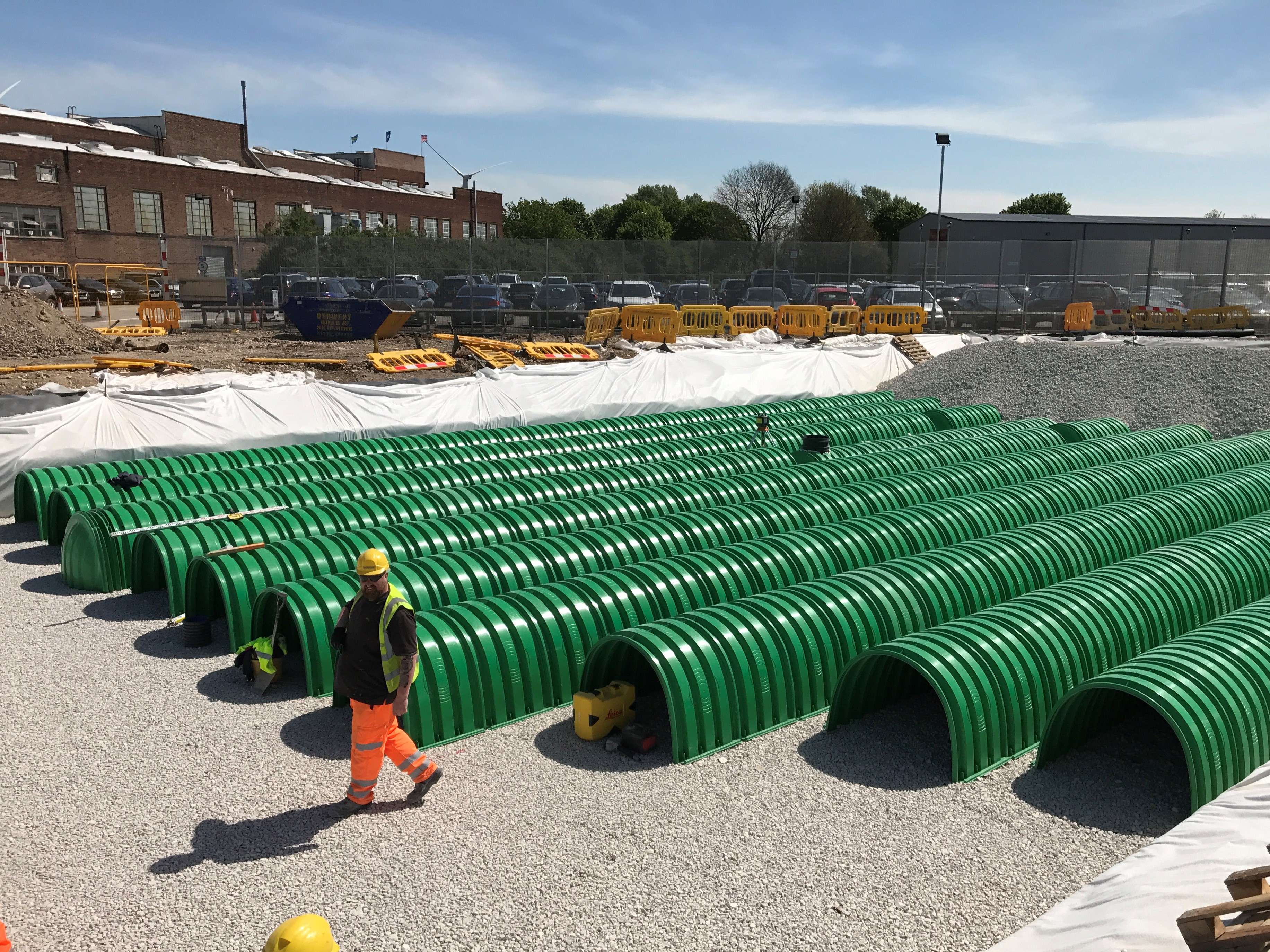
-
IKEA Project Sets New Standard
The Situation:
Developers of the new IKEA store in Jacksonville, Florida, wanted to make this project a model of sustainable, forward-thinking design. A big part of this plan was an underground stormwater management system that would be the largest ever installed in the southeastern United States.
The Challenge:
Along with the size of the installation, developers faced the task of coordinating runoff from a variety of sources into six separate basins around the building, while also meeting state and local regulations that required a minimum
separation between the bottom of the chambers and the Seasonal High Water Table (SHWT). The area also receives heavy precipitation, so a robust, large-storage-capacity system was needed to manage runoff and protect the area’s nearby water sources.
The Solution:
Although a competitive product had originally been spec’d for the project, Triton’s unrivaled strength, variety of sizes and engineering support convinced the developers that a change was warranted. Nearly 14,000 chambers were utilized, making this one of the largest chamber installations in the USA. Because of the multiple drainage basins, and their placement relative to the SHWT, Triton worked closely with the civil engineering team and the IKEA team to create the most efficient and economical solution to manage runoff from parking lots, rooflines and unimproved lands.
The Installation:
Because of the varied inputs of runoff, a multifaceted strategy was employed. The Triton system’s flexibility allowed developers to utilize Triton’s Main Header Row to filter out sediments where necessary, but also allowed for direct inlets into the Triton distribution (storage) chambers when the runoff was relatively sediment-free (such as rooflines) without having to add costly manholes.
After excavation of the six drainage basins, geofabric was laid in each and a bed of crushed stone was put down. Then the chambers and endcaps were installed. The developers used a combination S-29, C-10 and M-6 chambers on the project to achieve the specific strength and storage needs of each basin. The physical installation of the chambers took less than two weeks, despite the large number of chambers placed and the multiple installation sites.
After the chambers and endcaps were installed, a crushed stone layer was put over all chambers to prepare the sites for fi topping with pavement.
Because the Triton chambers are stronger than the competitive products, the project team was able to do less excavating and use less crushed stone – saving time and money!
The Result:
Because of Triton’s superior strength, variety of model sizes available, engineering support and storage capacity, the decision to switch from the originally spec’d competitive system saved 7,217 square feet of land, required 1,237 cubic yards less excavation and 2,130 cubic yards less of crushed stone while providing 3,032 more cubic feet of storage capacity!
The Jacksonville IKEA stormwater management system created 259,000 cubic feet of storage, without compromising the local hydrology, or eating up valuable retail and parking space.
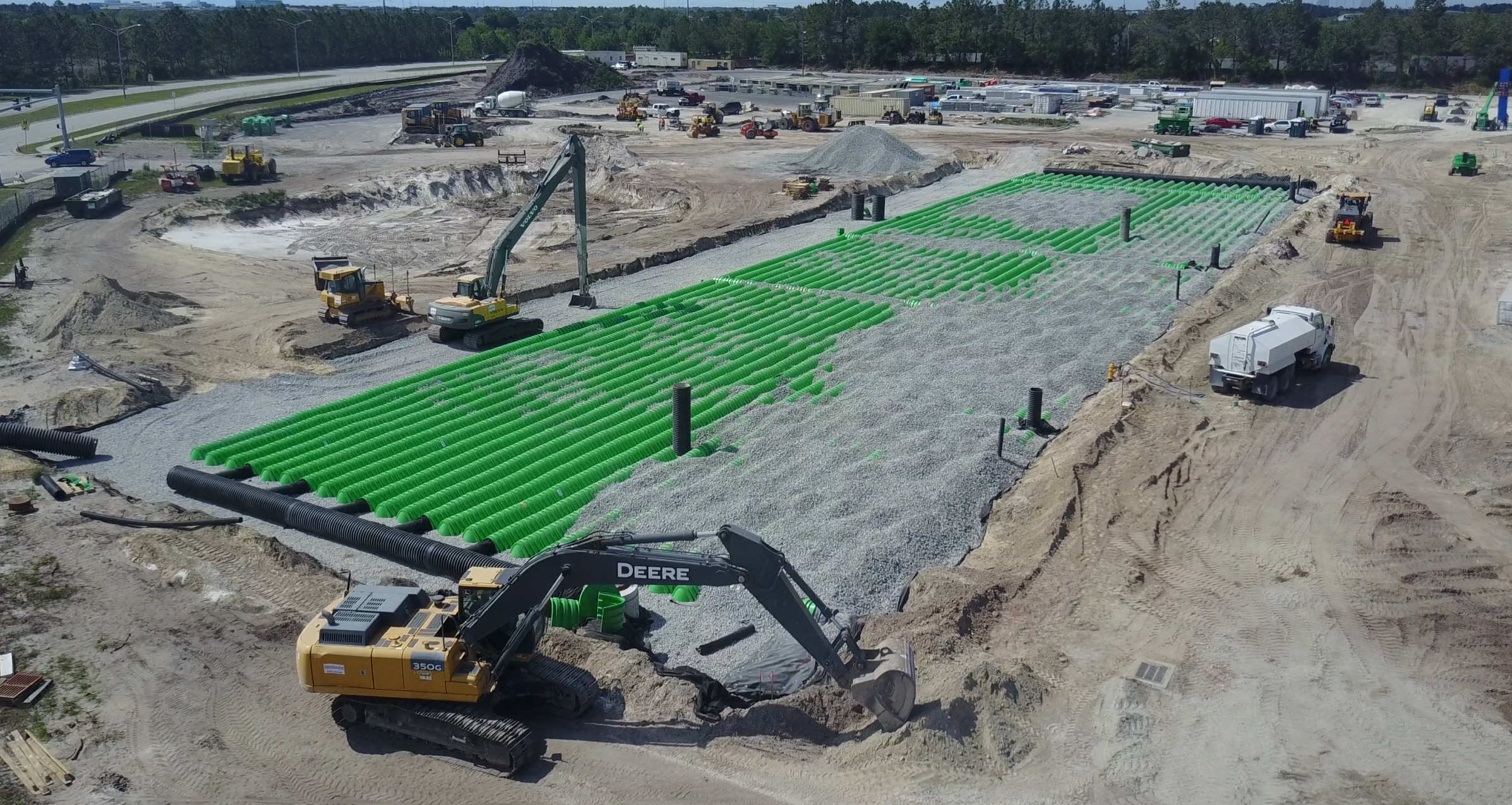
-
Brush Park-Detroit
The Situation:
Developers in the Brush Park area of Detroit, Michigan were having trouble constructing a stormwater system that dealt with all their needs.
The Challenge:
The project faced many issues, including limited space, contaminated soils and the need to accommodate utilities for the up-and-coming neighborhood. All of these problems had to be solved in a specialized and space-saving manner.
The Solution:
Instead of the planned stormwater pipes, Triton worked with Giffels Webster to provide 45,600 cubic feet of storage through 20 individual Triton Systems. The systems were also lined to prevent infiltration of contaminated soils into the stormwater. Due
to the strength of the S29 chamber material, side connections of up to 18†O.D. and top connections of up to 24†O.D. are doable while maintaining their H-30 load rating, which allows utility companies to work with and around the systems.
The Installation:
The site design laid out many challanges, but Triton Stormwater Systems pride themselves on their ease of installation. “This installation was one of the more difficult I have seen because of the site constraints.†Said Lead Triton Engineer, James Maier. “However, RBV Contracting, who had never worked with Triton before, quickly became experts in the installation of the liner, pipe boots and Triton Chambers.â€
The Result:
An 18,491 sq ft drain field providing 45,600 cubic ft of storage that effectively manages the storm water and allows for the inlet of 60 plus roof drains. This system will help further development of the Brush Park area. 20 individual Triton systems were implemented to facilitate the limited space.
WHAT THEY ARE SAYING
“The Triton System was very easy to install, while holding it’s integrity very well. The people at Triton were great
to work with as they came to our office pre-construction to meet with our team and made may site visits during installation to resolve any issues we were having. Triton was an excellent company to do business with.â€
– ADAM SHINABARGER – RBV FOREMAN
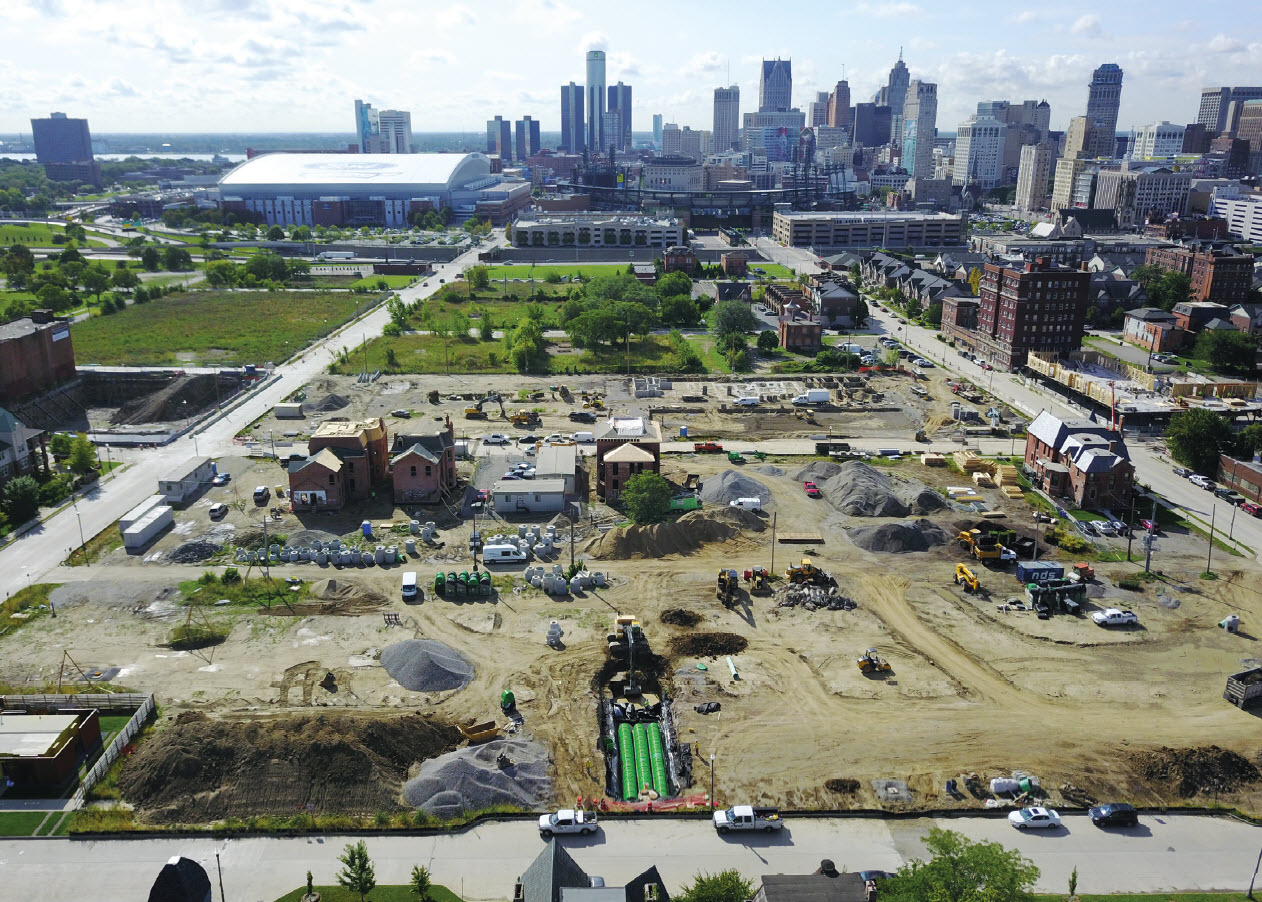
-
Triton Makes The Grades at University of Colorado
The Situation:
Contractors working with Colorado State University sought to develop a one-acre parcel to facilitate a multi- use trail and a parking lot on the Fort Collins campus.
The Challenge
Being an on-campus project, it was important that the job create as little disruption to university traffic as possible. Also, the finished lot had to be strong enough
to support fire-truck loads, due to safety standards. And these were just the above ground challenges.
The system also had to provide storage of 6,000 cubic feet of water in less than an acre of drain-field, and work with existing infrastructure elements. Additionally, because the water was ultimately to be released into downstream stormwater sewers, it had to have sediments and surface run-off contaminants removed.
WHAT THEY ARE SAYING:
“Triton was able to create a system that fi within the tight confines of the site, allowed us to maximize the above ground space and minimize downtime. Triton reacted quickly and met the deadlines for delivery, keeping things on track, despite the project timing around the Christmas Holiday.â€
– JACK KNAUB, HANES GEO COMPONENTS
“The Triton team was very responsive and they helped us work around the challenges presented by the tight timeline and the site constraints.â€
– ERIK NAKOS, JVA
The Solution
The Triton Stormwater Solutions underground chambers provided all the right answers. Triton’s innovative Main Header Row allowed for sediments to be trapped and easily removed before the water was sent to the storage chambers to slowly leach through the crushed stone base layer and exit the site.
Further, the modular design of the system allowed the development team to work within the tight confines of the site, and work with existing infrastructure. Triton’s strength was also a factor, as the chambers were able to easily handle the concrete top layer and support traffic loads that could include emergency equipment.
The ease of installation allowed the entire process to be completed within the aggressive two-week timetable.
The Installation
Site preparation included the excavation of the trench, laying of a geofabric cloth and establishing a foundation of crushed stone. A team of fi men then completed the chamber installation in two days, including all the necessary pipe connections between the Main Header Row and the Distribution Chambers. Next, the drainfi was backfi with crushed stone and a layer of soil was added to prepare for the concrete surfacing.
The Result
With a minimum of hassle to students and faculty, the developers were able to create a new parking area and a multi-use trail for the university community. The underground storage chambers provide attenuation
for 6,138 cubic feet of stormwater runoff, satisfying the needs of the project and protecting local waterways.
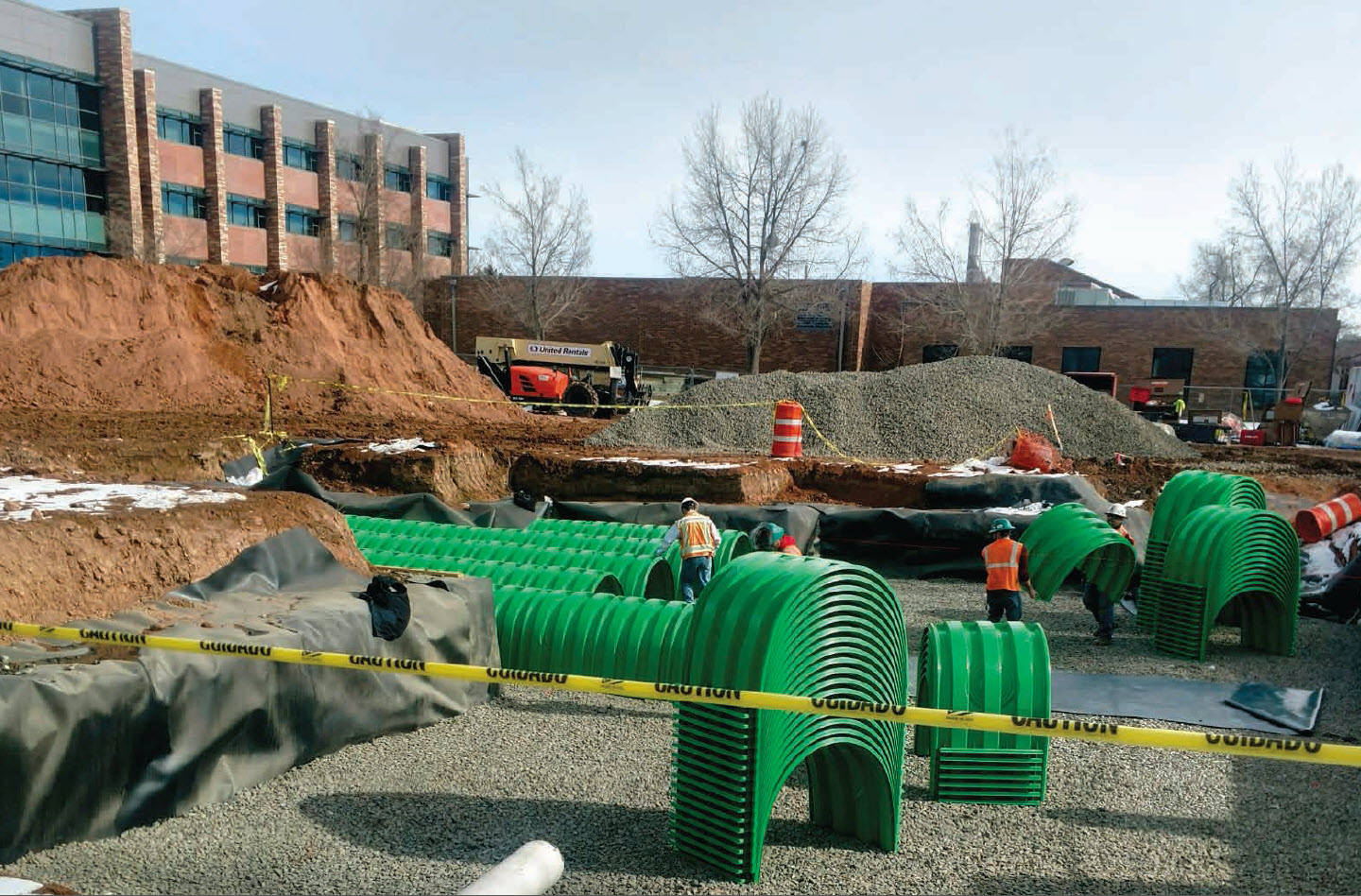
-
Growing Green
When most people think of storm water management, they envision large precipi-
tation events and a need to control heavy amounts of runoff. However, there is another side to the coin that is just as critical: gathering and protect- ing rainwater in areas where precipita- tion is sparse and water resources are jealously guarded.
It is in this environment that the Evans Greenhouse project arose. Based 30 miles outside Reno, Nev., in Wadsworth Township, Evans Greenhouse will imple- ment technologies to harvest and reuse rainwater to support a plant nursery and local firefighting needs.
“This area only gets 7 in. of rainwater a year, so we are trying to capture every- thing we can from the hardscape to be recycled and used to support irrigation and to build water reserves for the local fire department," said Jonas Sippala,
project manager.
“Instead of using the Triton chambers for underground dispersal, we lined the bottom of the trench with an impervi- ous EPDM [ethylene propylene diene monomer] liner,†Sippala said. “When water runs off the hard surfaces, it is sent through a filter before going into the chambers for storage. We created two risers that are fed by the stored water.
One of the risers is reserved for the fire department, and one riser is used to irri- gate the greenhouse plants.â€
The system utilizes a 12-V solar- powered pump to move the water, and the risers can be filled from underground wells during insufficient rainfall periods to meet the needs of the fire department or greenhouse.
Along with the Triton chambers, the system uses Environmental Passive Integrated Chamber (EPIC) technol-
ogy developed by Firestone Water
Management. The EPIC system utilizes a sand layer, which serves as a growing medium for plants, above the storage chambers to prefilter water as it enters the storage field.
A gravity filter and drip collection option will serve as further pretreatment sources for the water as it enters the Triton chambers.
“There is no soil absorption with the system,†Sippala said. “Everything is uti- lized by the plants or returned to storage.â€
A Sustainable Future
The current project, which includes the 4,000-sq-ft greenhouse and a 6,000-gal reservoir, is a prelude to bigger things
to come—in the fall, construction will begin on a 44,000-sq-ft greenhouse that will utilize the same technologies.
Project engineers estimate that the current system will return 17,360 gal of water from the 7 in. of rainfall the area
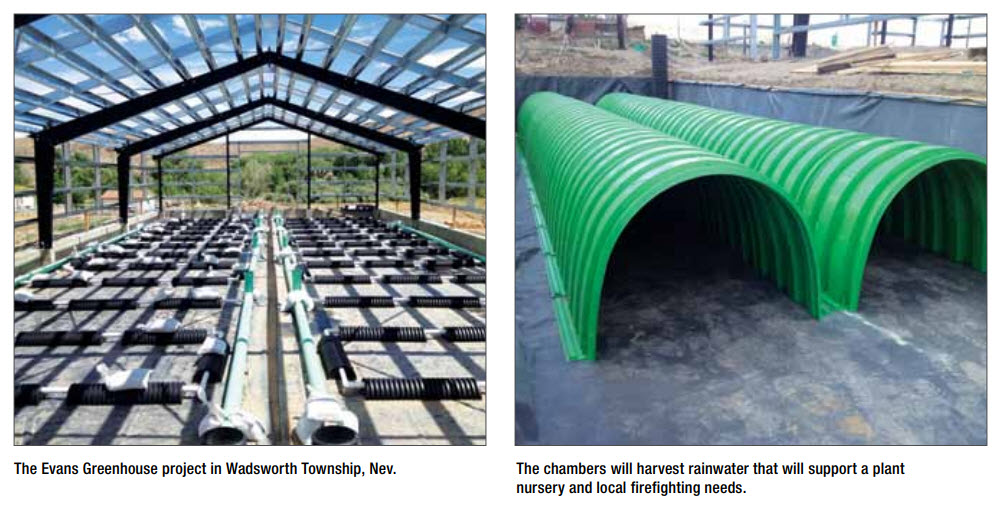
-
Ingalls Mall
Triton SWS Creates Win-Win for University of Michigan Project
Situation
The University of Michigan needed to upgrade its historic Ingalls Mall area of campus to modernize existing electrical and pedestrian lighting infrastructure, improve fire safety apparatus and expand its stormwater management capabilities.
The Challenge
Because the Ingalls Mall area is a major pedestrian throughway for students, faculty and visitors, construction activities had to be strictly confined to a small footprint – and completed as effi
as possible.
Further, the University needed to retain more of the Mall area’s stormwater onsite, with less outflow to the City of Ann Arbor’s storm sewer system. Because of the limited area available, the plan required a robust, underground system with proven storage capacity.
The existing system had storm receptacles serving as pre-treatment units for incoming water, so the new design had to incorporate sediment control and pre- treatment features along with improved retention.
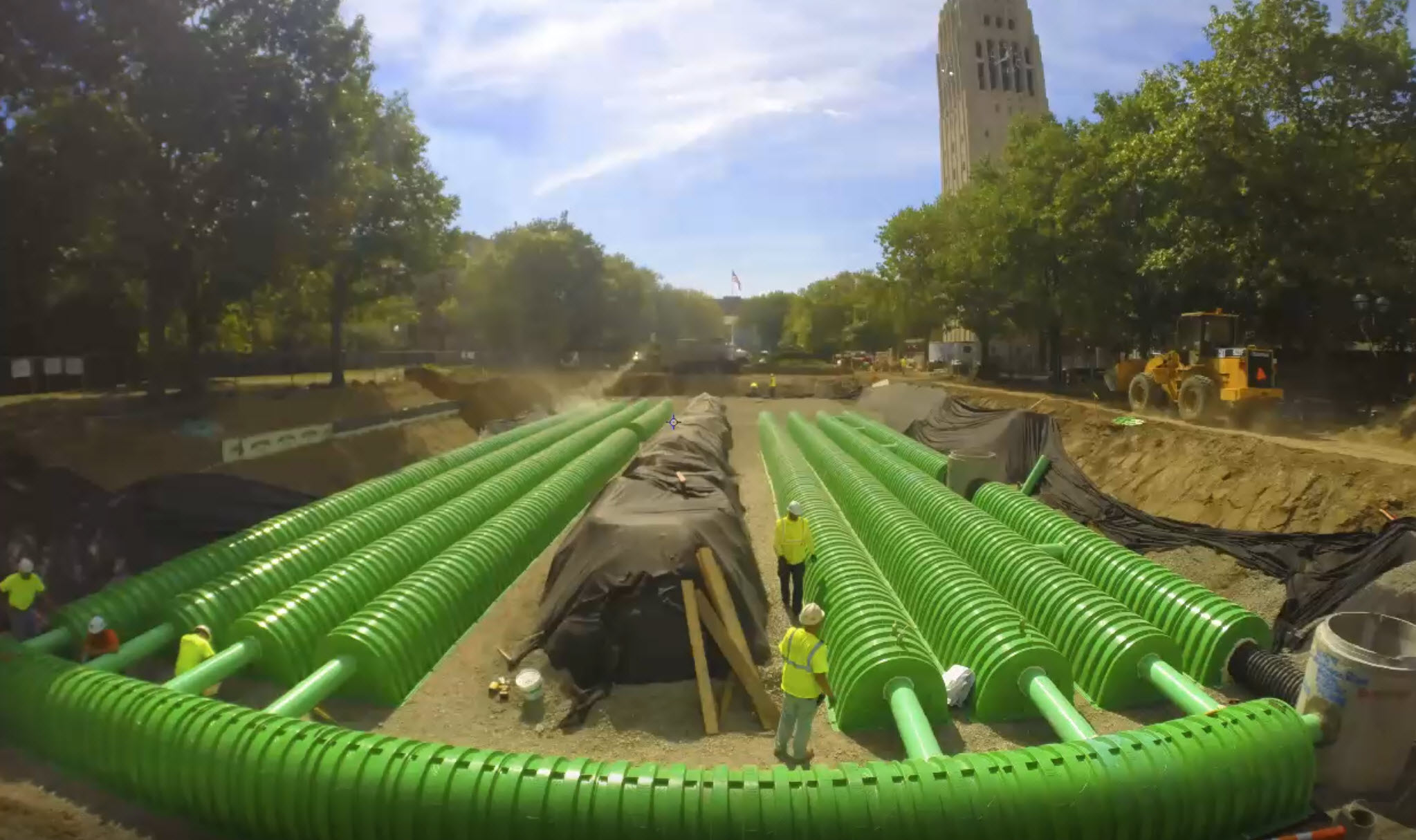
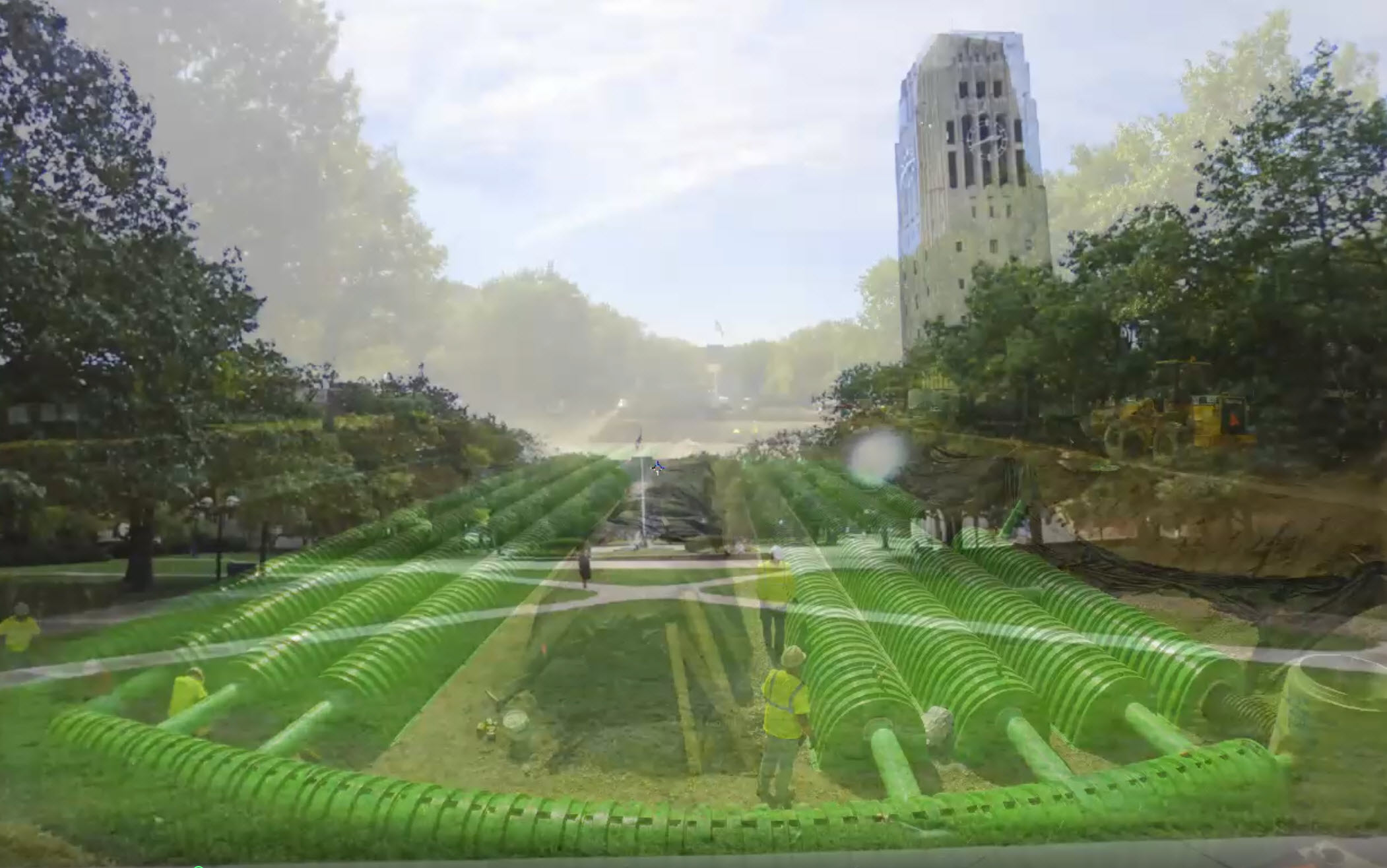
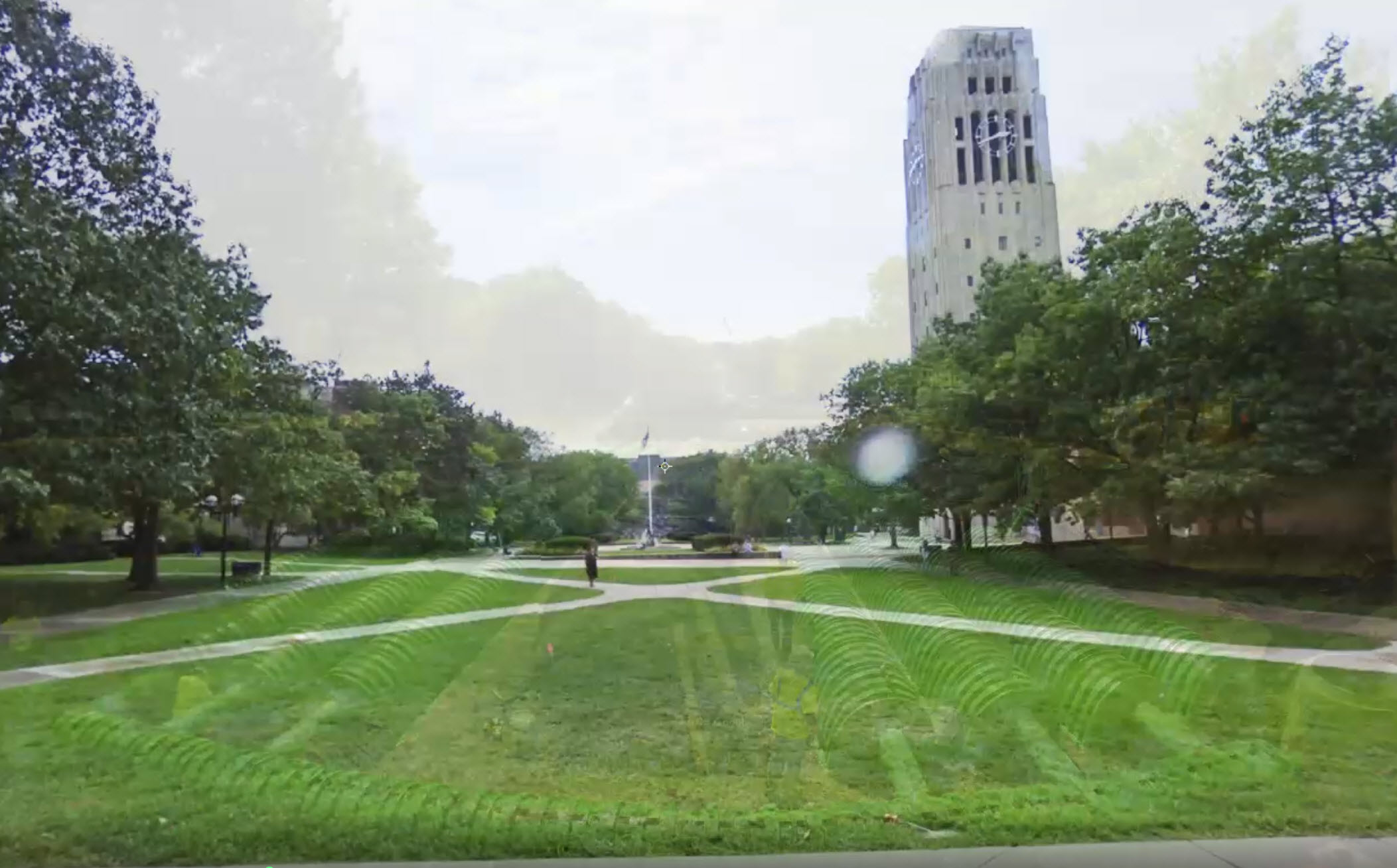
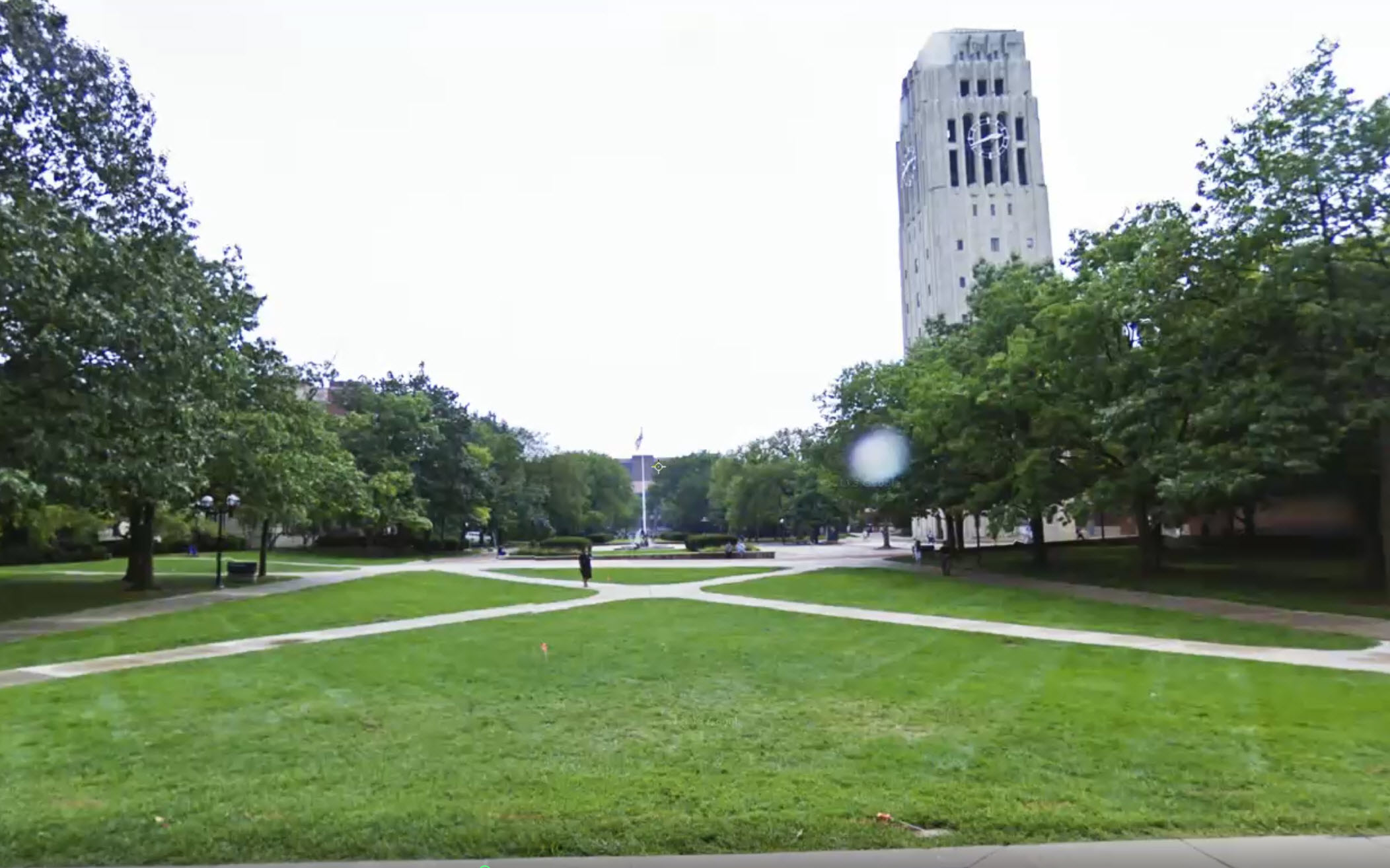
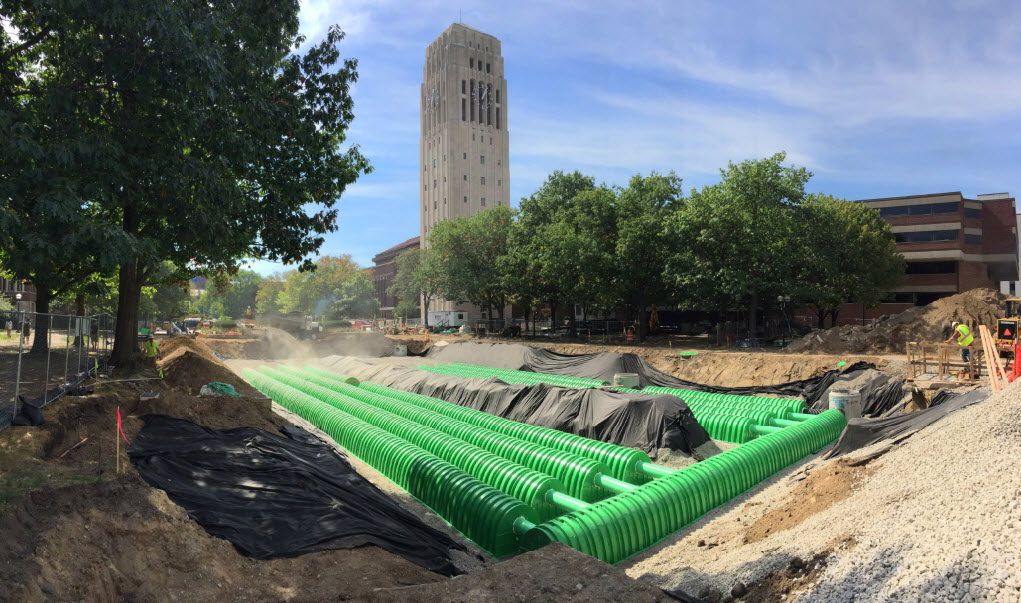
-
SJ Roberts Homes Project
Following an evaluation from Severn Trent Water’s New Products CoP Group Waste team, Triton Stormwater Solutions’ Stormwater Management System has been approved for use within Severn Trent on both AMP 6 Capital and Developer Sites.
SJ Roberts Homes latest development of 172 houses at Sweetlake Meadows in Shrewsbury required a stormwater management system to provide in excess of 1043m3 water storage. A fundamental requirement for the system was that it had to be adopted by Severn Trent Water.



-
Crane Bennett Project
When developers sought to create a new apartment development at the site of a longtime Minneapolis lumber yard, they knew that the supporting infrastructure would be a challenge. Spanning nearly a city block, the complex needed a state-of-the-art underground stormwater management system to support the construction, within the constraints of limited space. Additionally, the construction was going to take place in a busy urban area – closing streets or otherwise impeding daily traffic would be difficult and expensive.
To meet the requirements of the project, 14,131 cubic feet of stormwater storage was needed. Because of the site's constraints, project engineers chose to place two separate systems on opposite sides of the building.
Ultima…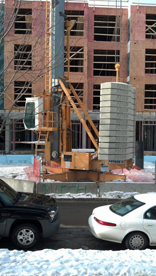
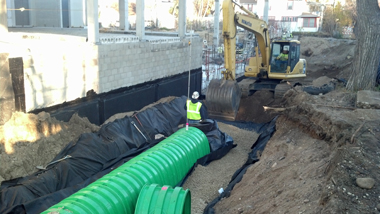

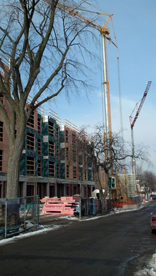
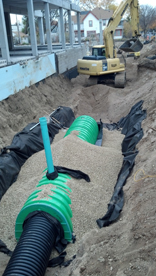
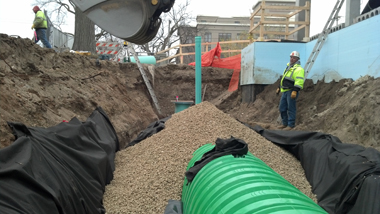
-
Duluth Airport Project
The desire to upgrade facilities and expand the travel options of people in the greater Duluth region led airport planners and the state of Minnesota to build a new terminal at Duluth International Airport. The new construction and associated impervious surface will cover roughly 13 acres, creating the need for a robust and easily maintained stormwater management system.
The Duluth area has several challenging aspects for developers – rocky landscapes and subsoil, extreme weather and an awe-inspiring natural environment that needs to be protected. Additionally, because of the problems associated with wildlife being attracted to the standing waters of retention ponds — and the risks this poses near airports – developers were required to…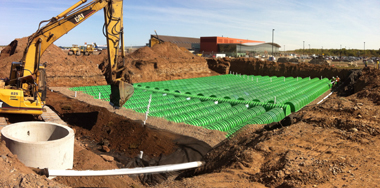
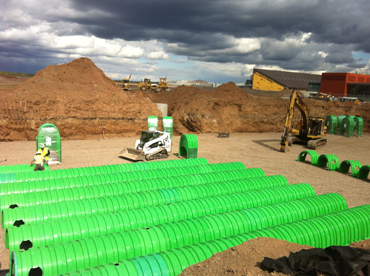
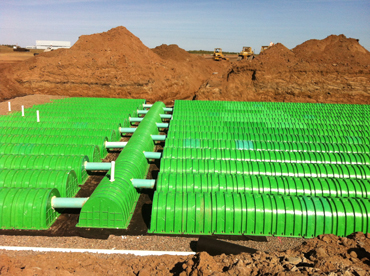
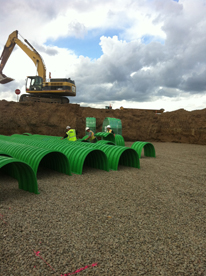
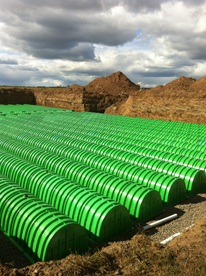

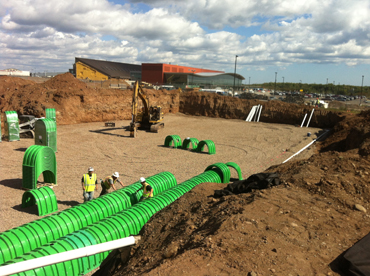
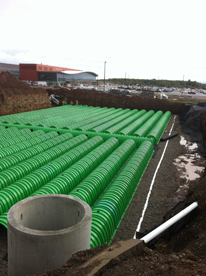
-
Unversity of St. Thomas
The University of St. Thomas needed a cutting-edge stormwater management system to support construction of a 180,000-square-foot athletic facility. The Anderson Athletic and Recreation Complex – which houses an aquatic center, 2,000-seat arena, a field house with 200m track, fitness facilities, locker rooms, and department offices for Athletics and Health and Human Performance – will become a showcase center for the St. Paul, Minn., school.
Because of the layout of the building, stormwater management needed to be done at two separate locations. This required coordination of equipment and manpower – but the Triton SWS' lightweight chambers, which require no heavy machinery for placement, helped ease this burden.
Additionally, initial so…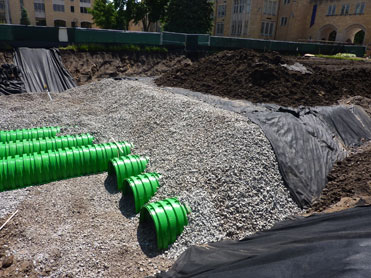
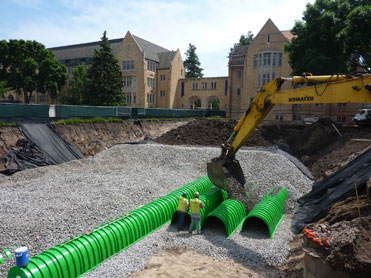
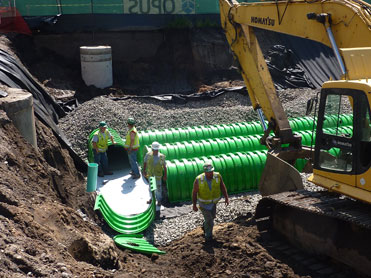
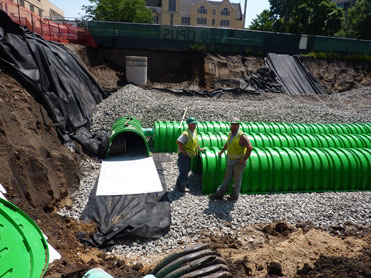
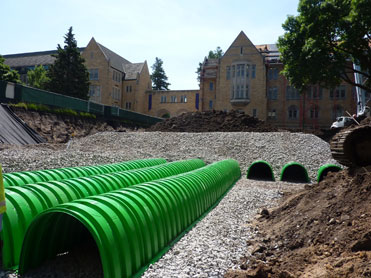
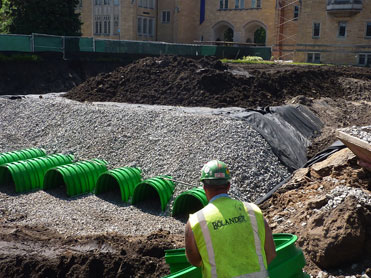
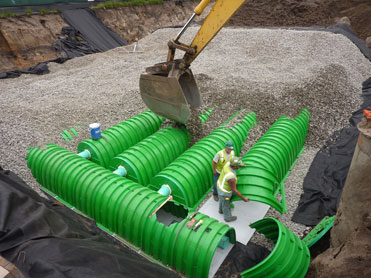
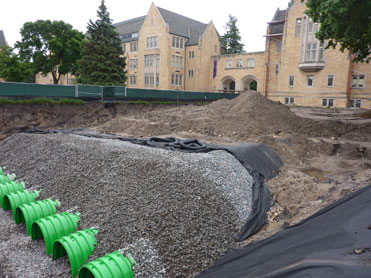
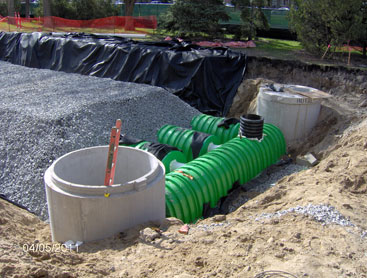
-
Lowes Home Improvement
Lowe's Home Improvement Centers needed strong, state- of-the-art underground stormwater management for its new store in Silverthorne, Colorado. The 11.5-acre site featured sloping terrain and required a small stormwater storage footprint with proven protection of water quality.
The Solution:
The Triton SWS chambers met the project engineers' needs on every level.
The layout of the project site meant that the underground chambers would need to be strong enough to withstand 21 feet of backfill weight. Additionally, the Siverthorne project site was subject to the stringent water-quality standards of the greater-Denver region.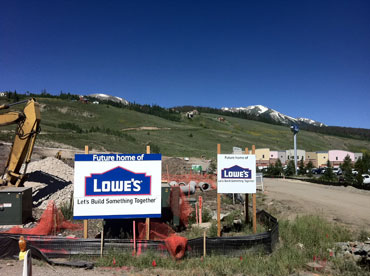
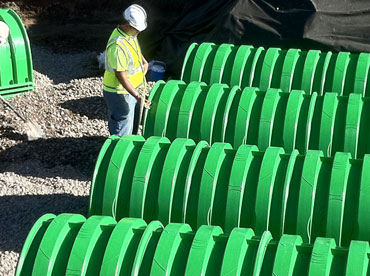
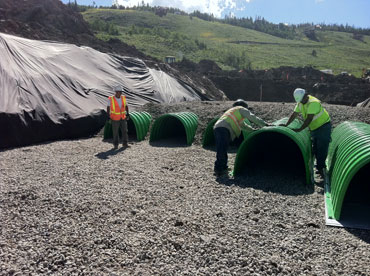
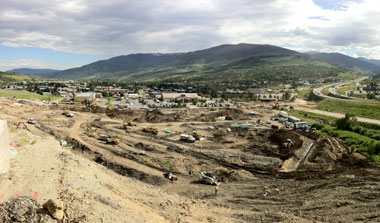
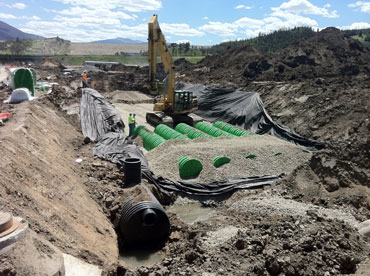
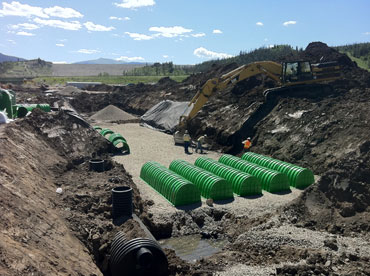
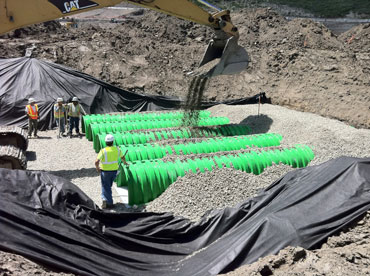
-
Toronto Retail Center
Engineers from Terrafix Geosynthetics needed a high-quality, high-strength, high-volume underground stormwater management system to support construction of a 600,000 square-foot retail center in Toronto.
The project demanded a small storm- water footprint with enough capacity to store the runoff from the shopping area and parking lots. Additionally, a system flexible enough to work with the existing site infrastructure, including a storage tank and large diameter underground pipe, was needed.
An added challenge was posed by the fact that the system would need to be strong enough to be buried 24 feet below the surface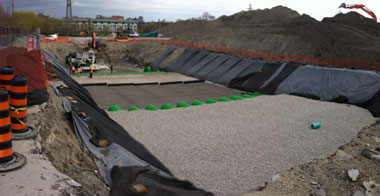
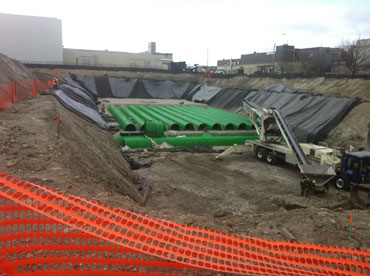
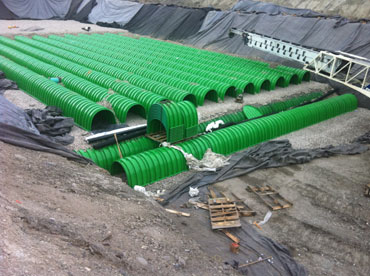
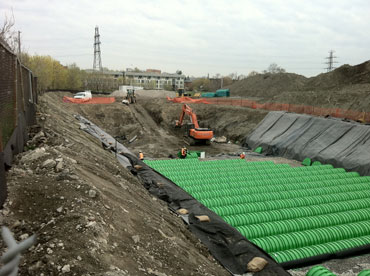
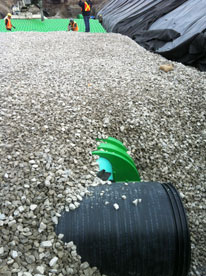

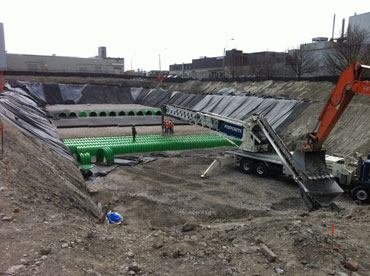
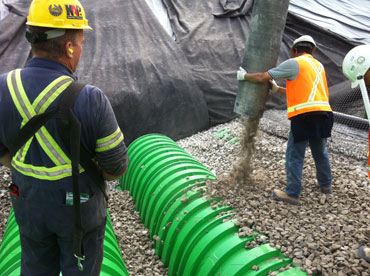
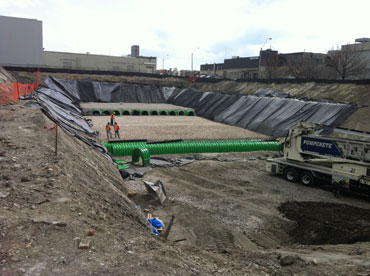
-
Metro Transit of Minneapolis/St. Paul
Metro Transit of Minneapolis/St. Paul needed to expand its Hiawatha Line operations and maintenance facility to meet the growing need for light rail travel in the Twin Cities. This required additional stormwater storage capacity – a big challenge given the constraints of the site; the numerous poles required to power the trains dotted the entire area, putting usable space at a premium, and demanding a flexible design.
Triton Stormwater Solutions innovative underground chambers, boasting large storage capacity and unrivaled strength – which allows them to be stacked to increase storage volume while saving space – meant that the project could meet the stringent requirements without disrupting the existing site infrastructure.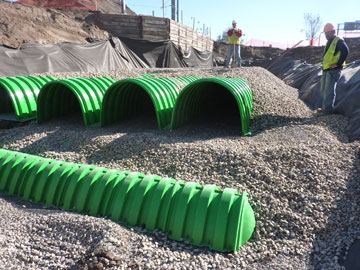



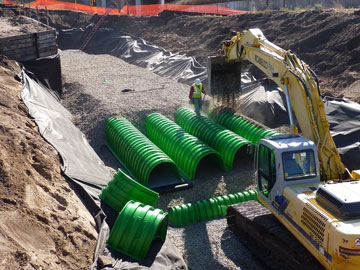
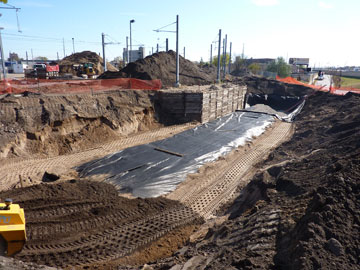
-
Scarsdale Veterinary Hospital
The new state-of-the-art Scarsdale Veterinary Hospital, located in the Pride Park business hub in Derby, UK, needed to upgrade its stormwater management capabilities to meet Britain’s new standards for control of 30-year rainfall event run-off.
As the law requires stormwater to be contained on site, project engineers wanted to be able to utilize underground storage techniques to save limited surface lands for needed uses, such as the parking lot for hospital patrons.
Significant storage capacity was needed, as the area contained nearly 30,000 square feet (2,787 square meters) of rooftops, as well as the hospital’s half acre (2,023 square meters) parking lot.
Because the system was to be placed beneath the parking lot, long…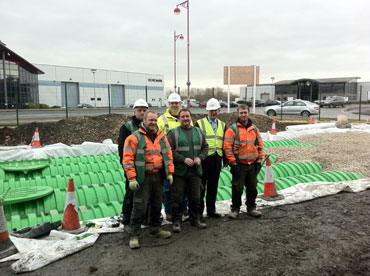
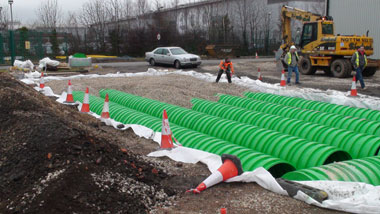
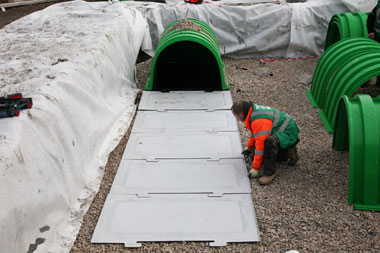
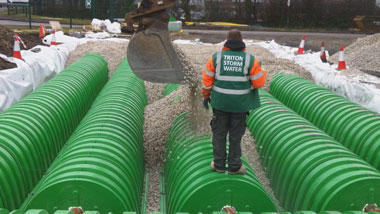
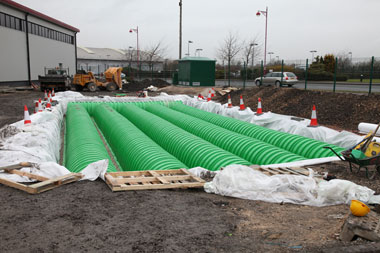
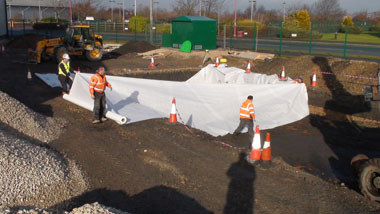
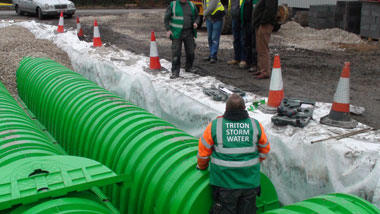
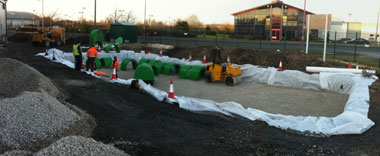
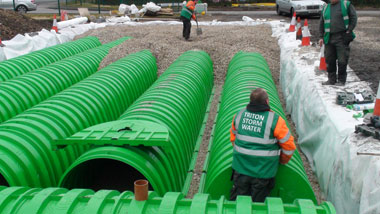
-
St. Cloud, MN Civic Center Expansion
The Situation
When the city of St. Cloud, Minnesota, needed a comprehensive underground stormwater management solution to support the expansion of its Civic Center, project engineers looked for a system able to accommodate the large volume of water associated with the new development that could also fit the restrictive footprint dictated by the site – while meeting the state's stringent B-3 guidelines for stormwater management.
The Solution
It was a tall order – considering that more than 3 acres of impervious surface would drain into a retention area of just 36' x 140'.
Fortunately, there is one system that can "stack" up against such a task.
With its unique combination of storage volume and strength, Triton Stormwater Soluti… -
Penn-DOT in Dubois
When the Pennsylvania Department of Transportation needed a stormwater management solution to support changes at a busy hospital intersection in Dubois, they initially spec'd a Triton competitor's product in the bid proposal. But, when the contractor suggested the Triton system as a time- and cost- saving alternative, Penn-DOT opened its ears and eyes.
Recognizing the Triton system's advantages in recreating pre-development hydrology, ease of maintenance, strength and storage capacity, Penn-DOT approved the Triton product, which also qualified the project for LEED credits.
The Dubois project called for storage of stormwater from the streets at the intersection, as well as the hospital's parking lot. It also needed to be robust enough t…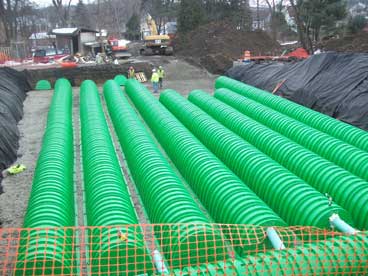
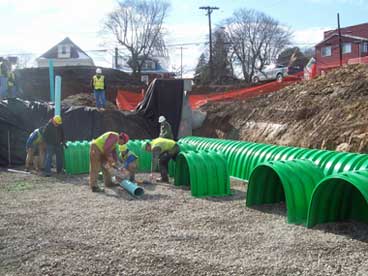
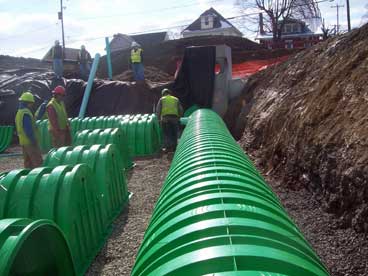
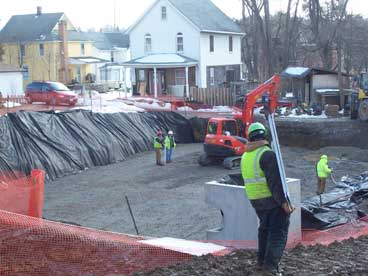
-
University of Hawaii Chooses Triton for New Oceanography Center
The Situation
The University of Hawaii outside Honolulu was building a new 30,000 square-foot addition to its existing Biomedical Science Building to house the Center for Microbial Oceanography: Research & Education (C-MORE).
The building was designed with sustainable design principles and energy-efficient strategies, and is currently targeting LEED Gold certification. Project manager Kimberly Polkinhorn, an associate with Group 70 International, noted that the Triton system was selected to minimize stormwater flow to the storm drainage system, and to allow the water to percolate back into the ground and recharge the water table.
Since the project site is in a rainy part of the island, minimizing run-off entering the overtaxed sto…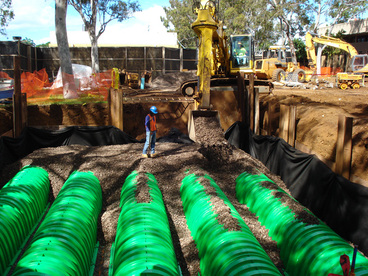
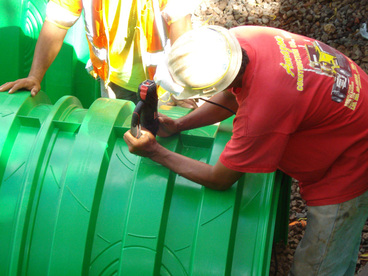
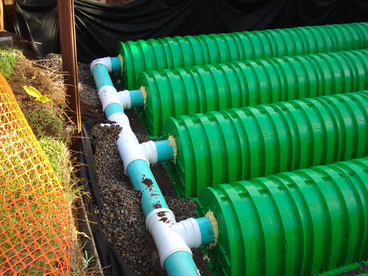

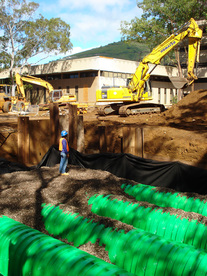
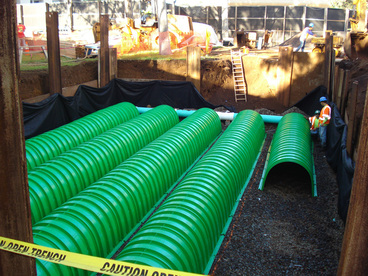
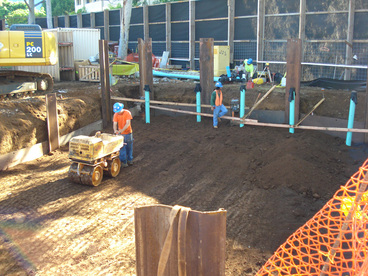
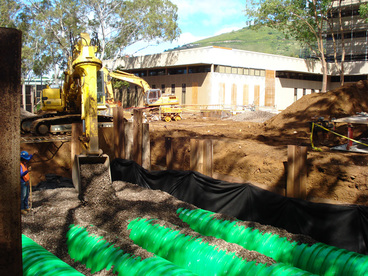
-
Luther Brookdale Chevrolet Dealership
The Situation
Luther Brookdale Chevrolet in Brooklyn Center, Minnesota was an older dealership in need of a facelift. “An entire renovation was taking place to improve both the inside and out,” explains
Lance Hoff, water resource engineer, Royal Environmental, a division of Royal Enterprises. New storm water chambers were necessary to meet regulatory requirements for the city and watershed district.
“We had to meet the 2 year, 10 year and 100 year storm events for rate control, and watershed requirements required us to use best management practice in infiltration,” explains Nathan Wallerstedt, design engineer, LandForm, who engineered the project. "In order to make our best effort we decided to use a bottomless system to ac…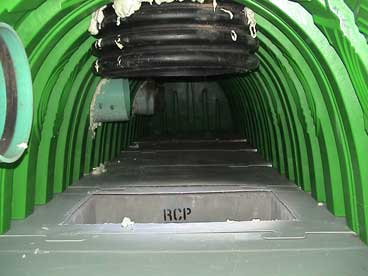
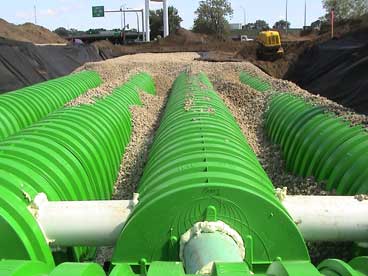
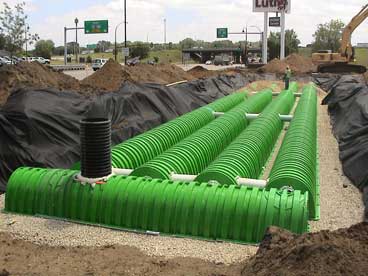
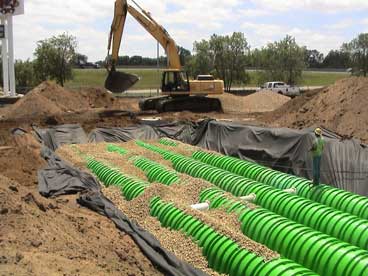
-
Starlite Metro Bus Transit
The Situation
The Starlite Metro Transit bus stop in the Brooklyn Park, Minn. commercial retail shopping center was in great need of improvement. The bus stop is located in a small triangular section of a fully developed mall parking lot that was still unpaved and serviced by a storm water pond. Metro Transit wanted to gain more usable space for this small area to serve the busses that pulled in and out all day by replacing the pond with an underground storm water system.
The Solution
Through its association with Royal Enterprises, a Triton stormwater detention system was selected to meet the unique design challenges of the site.
In addition to fitting an extremely small and triangular shaped area, the Triton system had t…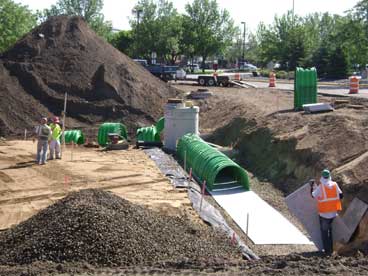
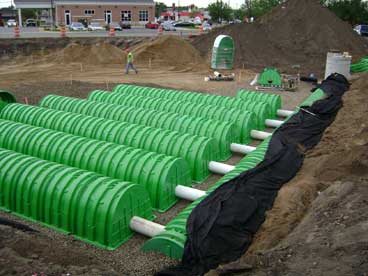
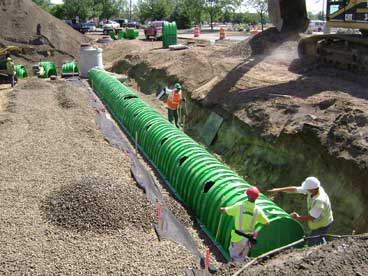
-
City of Maplewood
The Situation
The city of Maplewood, a metropolitan suburb of the Twin Cities in Minnesota, needed to make some improvements on a key roadway called Castle Avenue. There were several issues at hand, according to Steve Kummer, staff engineer, City of Maplewood, who designed and engineered the project.
“First, the pavement was in very poor shape,” he explains. “Second, we are expecting future development in that area that we had to accommodate by widening the road. Lastly, we had to implement some traffic calming measures to increase safety along the roadway, such as adding curb and gutter and adjusting the existing roadway profile so folks slow down when they go around the curve and downhill.”
In addition, the city had to meet a…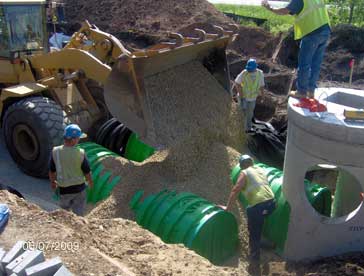
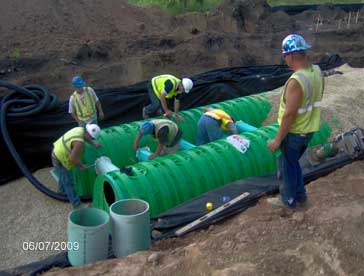

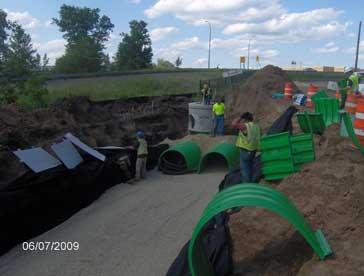
-
Champion Jeep Dealership
The Situation
A few years ago, local businessman Len Nadolski was considering purchasing the vacant Pontiac Buick dealership in Lansing, Mich., an older dealership that had been closed a few years. Nadolski wanted to remodel the existing building and add 10,000 square feet to renovate it into a Chrysler Jeep Dodge dealership. Chrysler was encouraging its dealers to revamp their stores into these “Alpha” dealerships, with all Chrysler brands under one roof. The only problem was that the dealership had a stormwater eaement that went across the neighbor's property.
“While considering the purchase, the neighbor closed off the easement which just about killed the deal,” explains Stan Schafer, owner of Schafer Construction in Bright…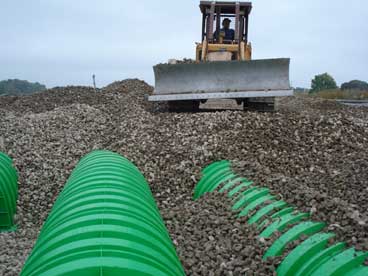
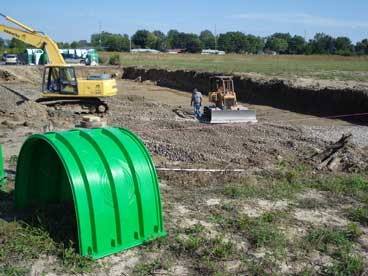

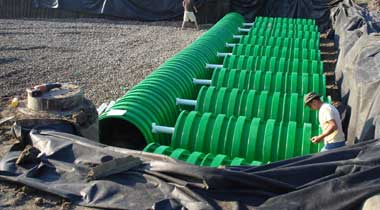

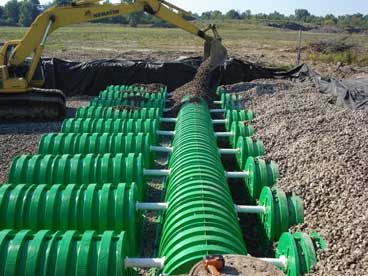
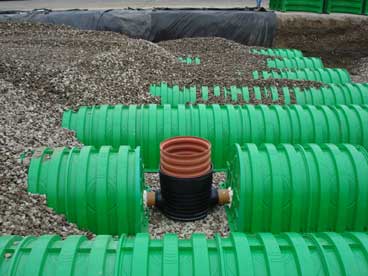
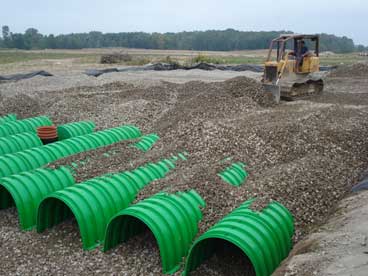
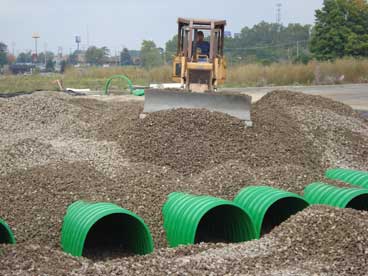
-
Fast Food Restaurant Upgrade
The Situation
An existing fast food restaurant, located within the fully developed St. Paul, MN city limits, was greatly in need of an update. Not only did the store itself need a facelift, but the property needed to be redeveloped to meet the new watershed requirements that had been put in place since the area was originally developed. Requirements dictated infiltration, filtration and rate control of stormwater to be used on redevelopment projects within its watershed districts.
The site contained an above ground detention holding pond that was not adequate with current standards for water retention. Heavy rains would cause the pond to overflow and flood the local area.
The land itself was more valuable than the pond due to the …






-
Keyser Shopping Complex
The Situation
Keyser, West Virginia, a small town outside Cumberland with an estimated population of just 5,515, had nothing in the way of retail besides a Wal-Mart. So when a local entrepreneur decided to build a new $7 million outdoor shopping complex on the outskirts of town, it was a big deal for local residents.
"This was much-needed and very exciting, "explains Kevin Sandridge, of Norco, who served as project manager. "There was nothing here before but a field with mountains on either side." Seven acres of the 15 acre site were partially developed to include two large buildings 91 feet wide by 260 feet and 380 feet long, respectively. Parcels are available to be sold off for future free –standing buildings such as banks, rest…













-
International Place
The Situation
International Place, a six-story office building in Shelton, Connecticut needed additional parking. However, the pond detention configuration in use didn't allow for the parking lot to be expanded.
The project faced the additional challenge of only being able to work from two sides of the building as the other areas extend into a wetland.
The Solution
Through its association with Environment 21, LLC, a Triton Stormwater Solutions retention system was selected by Connecticut Pre-Cast, the developer's supplier for manhole storm systems. The Environment 21 design and engineer team worked with Connecticut Pre-Cast to develop a design and layout that met the project needs for stormwater hydraulics and site constraint…





-
Walser Honda Dealership
The Situation
Located south of the Twin Cities in Burnsville, Minnesota, Walser Honda needed to expand their parking lot to maximize the usable area for both retail sales and customer parking. The site did not allow room for traditional storm water storage, but required an underground system to be installed under the entire parking lot site. Triton Stormwater Solutions in Brighton, Michigan was selected as the stormwater system provider.
Triton's proprietary design and patented construction offers larger-capacity, lighter-weight, easier-to-install stormwater chambers that are more than 50 percent stronger than traditional products. Triton stormwater chambers have 46 percent greater capacity per linear foot and withstand 16,000 more… -
Green Oak Township, Michigan
When homeowner Brent Zinn bought his house last December, he had a rude awakening come spring.
"My walk-out basement doors are at the lowest point in the neighborhood," he explains. "When the ground thawed, the water from melting snow and ice basically rolled down the ground and straight into my finished basement. There was a tremendous amount of water coming in."
Built in 1991, the yard was never graded properly. This past winter was particularly harsh with several large snowfalls. "The ground would warm up then freeze again and again creating ice which basically sealed up the ground and prevented water from soaking in," says Zinn.
The previous homeowners had a 55 gallon trashcan filled with rocks buried underground that would collec…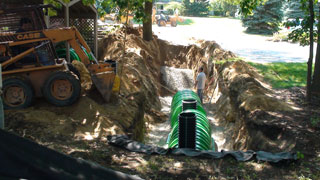

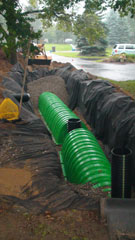
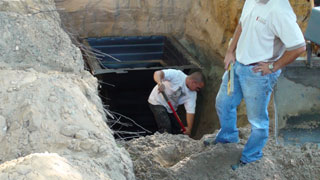
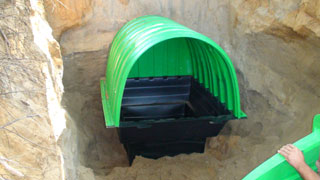
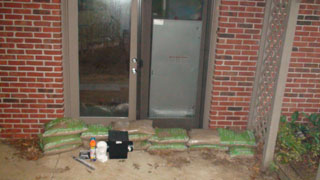
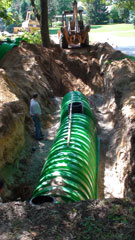
-
Monterey Bay Idea House
The Situation
The Monterey Bay Idea House, the latest in the line of select West Coast homes built by Sunset magazine to showcase new and exciting products, presents a multitude of eco-friendly features in response to the need for energy efficiency, function and sustainability.
Located in an exclusive residential community in the mountains overlooking the ocean, the house was designed working closely with Monterey County to illustrate how green building can be done. “The county wants to encourage going green by expediting permits and offering other incentives,” explains Tom Messenger, who served as project manager. "The Monterey Bay House needed to be at least 70 percent green through environmentally-friendly features such as the u…
